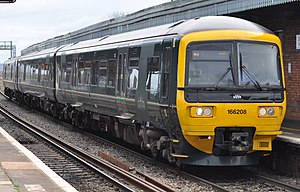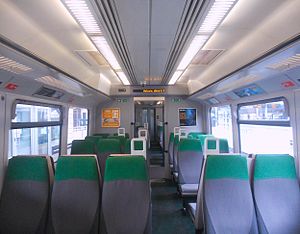
Back BR-Klasse 166 German イギリス国鉄166形気動車 Japanese British Rail Class 166 Polish British Rail Class 166 Russian British Rail Class 166 SIMPLE
| British Rail Class 166 Networker Turbo | |
|---|---|
 Great Western Railway Class 166 at Didcot Parkway in 2015 | |
 Refurbished standard-class saloon | |
| In service | 11 May 1993 – present |
| Manufacturer | ABB Transportation |
| Built at | Holgate Road Works, York |
| Family name | Networker Turbo |
| Replaced | |
| Constructed | 1992–1993 |
| Number in service | 21 |
| Formation | 3 cars per unit: DMCL-MS-DMSL[1][2] |
| Fleet numbers | 166201–166221 |
| Owners | Angel Trains |
| Operators | Great Western Railway |
| Depots | St Philip's Marsh (Bristol) |
| Lines served | |
| Specifications | |
| Car body construction | Welded aluminium |
| Car length |
|
| Width | 2.81 m (9 ft 3 in)[1] |
| Doors | Double-leaf sliding plug (2 per side per car) |
| Maximum speed | 90 mph (145 km/h)[1] |
| Prime mover(s) | 3 × Perkins 2006 TW-H (one per vehicle) |
| Engine type | Inline-6 4-stroke turbo-diesel[3] |
| Displacement | 12.2 L (742.64 cu in)[3] per engine |
| Power output | 260 kW (350 hp) per engine |
| Transmission | Voith T 211 rz[1] (hydrokinetic, one per vehicle) |
| UIC classification | 2′B′+2′B′+B′2′ |
| Braking system(s) | Electro-pneumatic (disc) |
| Safety system(s) | |
| Coupling system | BSI[4] |
| Multiple working | Within class, and with Class 165[5] |
| Track gauge | 1,435 mm (4 ft 8+1⁄2 in) standard gauge |
The British Rail Class 166 Networker Turbo is a fleet of diesel-hydraulic multiple unit passenger trains, built by ABB Transportation at their Holgate Road Works in York between 1992 and 1993. They were specified by and built for British Rail, the state-owned railway operator in Great Britain at the time. The trains were designed as a faster, air-conditioned variant of the Class 165 Turbo, intended for longer-distance services, and, like the 165s, belong to the Networker family of trains. They are known as Networker Turbos to distinguish them from the electrically propelled members of that family. Today the 166s, alongside the 165s, are normally referred to as Thames Turbos, the Networker Turbo Express or just simply Turbos.
The Class 166s are still in service today, solely operated by Great Western Railway. Until 2017, they operated only on express and local services in the Thames Valley area alongside the Class 165 units. In this time, they were based at Reading TMD but since July 2017, the 166 units have been gradually moved over to be based at St Philip's Marsh depot to operate local and regional services around Bristol and Exeter. Nowadays, the majority of the 166s are based in Bristol while many 165s remain in the Thames Valley.
- ^ a b c d e "Class 166". London: Angel Trains. Archived from the original on 6 May 2021. Retrieved 29 December 2021.
- ^ Cite error: The named reference
additionalwas invoked but never defined (see the help page). - ^ a b Perkins 2000 Series User's Handbook (PDF) (12th ed.). Shrewsbury: Perkins Engines Company. May 1999. p. 9. TSD 3215E. Archived (PDF) from the original on 27 January 2018. Retrieved 7 December 2022.
- ^ System Data for Mechanical and Electrical Coupling of Rail Vehicles in support of GM/RT2190 (PDF). London: Rail Safety and Standards Board. 22 June 2011. p. 4. SD001. Archived from the original (PDF) on 1 April 2012. Retrieved 22 November 2022.
- ^ Webster, Neil; Hall, Peter; Fox, Peter (2001). British Railways Locomotives & Coaching Stock 2001. Sheffield: Platform 5 Publishing. pp. 207, 208. ISBN 1-902336-19-4.